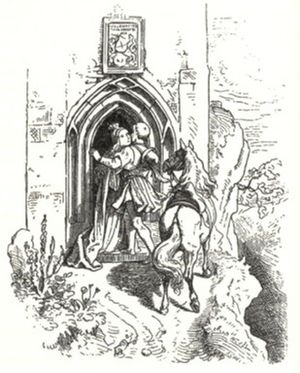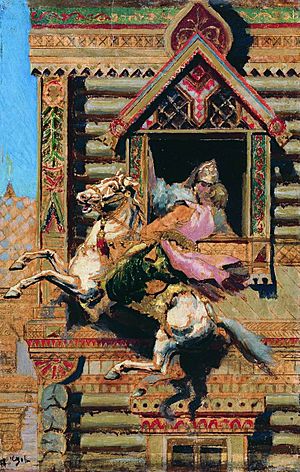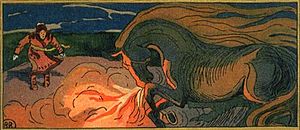The Princess on the Glass Hill facts for kids
Quick facts for kids The Princess on the Glass Hill |
|
|---|---|
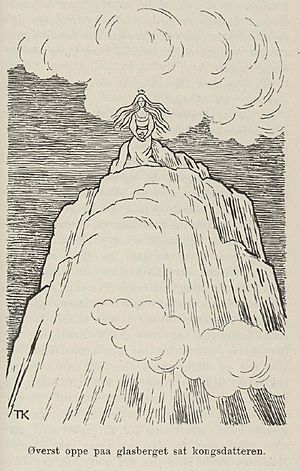
The princess sits atop the steep glass hill. Illustration from Barne-Eventyr (1915).
|
|
| Folk tale | |
| Name | The Princess on the Glass Hill |
| Data | |
| Aarne–Thompson grouping | ATU 530 (The Princess on the Glass Hill) |
| Country | Norway |
| Published in | Norske Folkeeventyr, by Asbjornsen and Moe |
"The Princess on the Glass Hill" is a famous fairy tale from Norway. It was collected by Peter Christen Asbjørnsen and Jørgen Moe in their book Norske Folkeeventyr.
This story is about a brave young man, often called "Boots" or "Cinderlad," who is the youngest of three brothers. He finds a magical horse and uses it to win the hand of a princess. The tale is so well-known that a whole group of similar stories around the world is named after it: Aarne-Thompson-Uther (ATU) type 530, "The Princess on the Glass Hill."
Contents
What's the Story About?
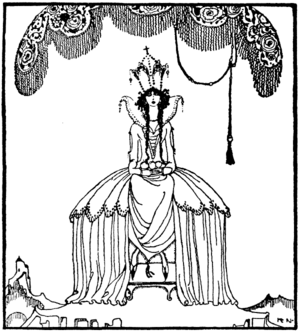
A farmer had a big problem: something kept eating his hay every year on Midsummer's Eve. He sent his two older sons to guard the field, but they were scared away by earthquakes.
His youngest son, Boots (who his brothers made fun of because he often sat by the ashes), decided to try. He stayed through three earthquakes. After the last one, he saw a magical horse eating the hay. Next to the horse were a saddle, a bridle, and a full suit of armor made of brass. Boots used a piece of steel from his tinderbox to tame the horse. He rode it home secretly and pretended nothing happened.
The next year, the same thing happened, but the horse's gear was made of silver. The year after that, it was all made of shining gold.
Meanwhile, the king of the country had a beautiful daughter. He announced that whoever wanted to marry her had to climb a very steep glass mountain. The princess sat at the top with three golden apples. Whoever could reach her and take the apples would marry her and get half the kingdom.
On the day of the challenge, Boots's brothers wouldn't let him come along. Many knights and princes tried to climb the mountain, but they all failed. Then, a mysterious knight appeared, wearing brass armor. He rode a third of the way up the mountain. The princess was very impressed and threw him one of her golden apples. The knight quickly rode away before anyone could see who he was.
At the next challenge, the knight returned with silver armor. He rode two-thirds of the way up, and the princess threw him the second apple. Again, he vanished quickly.
For the third and final challenge, the knight wore magnificent golden armor. He rode all the way to the top, took the third golden apple from the princess, and then rode off before anyone could catch him.
The king ordered everyone in the kingdom to come forward. Boots's brothers arrived, and the king asked if there was anyone else. They laughed and said Boots had just been sitting in the ashes. But the king sent for him. When Boots arrived, he showed the king the three golden apples. The king realized he was the brave knight. So, Boots married the princess and received half the kingdom.
Where Else Is This Story Told?
This fairy tale is very popular and has been told in many different ways all over Europe, and even in parts of Asia and the Americas! It's amazing how a story can travel and change.
Tales from Europe
The story is especially popular in countries like Norway, Sweden, and Denmark. In these places, there are many versions of the tale. Sometimes the hero guards his father's grave instead of a hayfield, and a magical helper gives him the horses.
In Germany, a similar tale is called Hirsedieb ("The Millet-Thief"). Another German version, Old Rinkrank, also features a king who puts his daughter on a glass mountain for suitors to climb.
Tales from Poland often feature a "Glass Mountain" and a foolish youngest brother who gets help from a magical horse or spirit. In some Polish stories, the hero uses the horse to grab a ring or other item from the princess.
In Russia, the story is often called "Sivko-burko" after the magical horse that breathes fire! The hero, often a simple boy named Ivan, uses this horse to reach the princess in a high tower.
Many versions exist in Slovakia and the Czech Republic. Here, the hero might be called "Ashface" or "Honza." He often gets help from a mouse or other magical creature to tame the horses and win the princess by taking items from her high up in a castle.
In Hungary, the tale is known as "The Cinderella Prince." The hero might share food with a frog or a mouse, who then helps him get the magical horses needed to win the princess.
The story is also very popular in the Baltic States like Estonia, Finland, Lithuania, and Latvia. In some Estonian versions, the princess sleeps for seven years in a glass coffin on the mountain. In others, the hero gets help from his father's spirit after visiting his grave.
Tales from Asia and Beyond
The story has even traveled to the Middle East and India. In an Indian version, the king's garden is trampled by magical horses, and the youngest son tames them. He then uses them to win the princess by throwing a ball to her.
In West Africa, there's a similar tale called Jomma, where the hero, disguised as a leper, tries to win a princess sitting on a silk-cotton tree.
The Story in Plays and TV Shows
This popular tale has inspired many adaptations. A famous Latvian poet named Rainis wrote a play called Zelta zirgs ("The Golden Horse"), where the hero Antiņš must save the princess sleeping on the glass mountain.
Two Hungarian versions of the story were even made into episodes of a Hungarian TV series called Magyar népmesék ("Hungarian Folk Tales").et:Kuningatütar klaasmäel fr:Sivko-Bourko ru:Сивка-бурка


